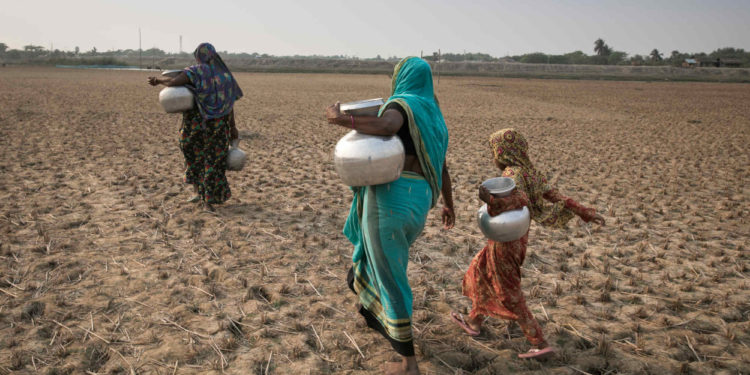Md Hasanur Rahman Tanzir – The impact of high salinity, on the other hand, is a severe crisis of pure water. The people of three southern coastal districts are facing two crises in the current drought. They are crying out for safe and drinkable water. Women have to walk miles and miles to collect water every day. There are allegations: Although projects have been implemented at the government and private levels at a huge cost to resolve the crisis, no benefits have been achieved in the long term.
According to information from various private organizations, at least three lakh families in 48 unions in 9 upazilas of Khulna, Bagerhat and Satkhira districts are facing a drinking water crisis. Among them, the drinking water crisis is increasing among the residents of Koyra, Paikgachha and Dakop upazilas of Khulna district. In addition, a new drinking water crisis has also emerged in several areas of Batiaghata and Dumuria upazilas.
On the other hand, the results of a 2021 United Nations Development Programme (UNDP) survey show that 73 percent of people living in Koyra, Dakop, Paikgachha in Khulna district and Asashuni and Shyamnagar upazilas in Satkhira are drinking unsafe saline water. If the salinity is more than 1,000 milligrams per liter, it is considered unfit for drinking. However, the water in those upazilas has a salinity of 1,427 milligrams to 2,406 milligrams per liter. 52 percent of ponds and 77 percent of tube wells in these areas have been found to have high levels of salinity.
According to the average calculation of the survey, the ponds in Dakop upazila have been found to have a salinity level of 650 milligrams, Koyra has 1,024 milligrams, Paikgachha has 1,581 milligrams, Asashuni has 1,003 milligrams and Shyamnagar has 1,184 milligrams. In addition, the salinity levels in tubewell water are: 2,406 milligrams in Dakop, 1,453 milligrams in Koira, 1,510 milligrams in Paikgachha, 998 milligrams in Asashuni, and 1,683 milligrams in Shyamnagar.
The Department of Public Health Engineering said that in the last five years, 8 government projects have been implemented at a cost of Tk 525 crore to solve the drinking water crisis and provide clean water in the three coastal districts of Khulna, Bagerhat and Satkhira. Of this, Tk 215.76 crore was spent in Khulna, Tk 286.58 crore was spent in Bagerhat and Tk 216.58 crore was spent in Satkhira. At least 10 types of technologies and methods have been used in these projects. Among them, deep and shallow tube well installation, reverse osmosis, rainwater harvesting, pond digging technology are among them. In addition, 16-20 private organizations have implemented more than 50 more projects.
However, the coastal residents concerned complain that no technology or method has yielded long-term benefits. The water treatment plants have also not been sustainable. As a result, they are forced to turn to unsafe water sources.
Kaushik Bairagi, a resident of Chunkuri village in Bajua union of Dakop upazila of Khulna, said that three PASF (Pond Water Purification Technology) were installed in his area in the last five years. The first one broke down within a year. The next two are also not functional. As a result, one has to travel far to collect water.
Rabeya Begum and Jabeda Begum, residents of Jaberer Kheaghat area of Pankhali union in the same upazila, said that there is no drinking water facility anywhere within three kilometers. As a result, they have to walk for miles to collect water every day. When they cannot find water anywhere, they often have to collect unsafe water from ponds and drink it. Unsafe water is also used for other daily purposes. Due to this, they are suffering from various water-borne diseases.
Maula Baks Gazi, a resident of Koyra upazila, said that drinking water is a big problem. Although deep tube wells have been installed many times in some villages including Mayali and Kalikapur, sweet water has not been found. In addition, the water is sour and contains iron. This water cannot be used for other purposes except for washing dishes, bathing and toilet use. As a result, they have to buy water from private organizations (plants). Many do not have the financial means to buy it. As a result, their only hope is pond water. But there is no rain, and the reservoirs are also drying up due to drought.
Koyra Upazila Executive Officer Ruli Biswas said that out of the seven unions in Koyra Upazila, three upazilas, Maheshripur, Amadi and Bagali unions, cannot be installed. Rainwater harvesting and reservoirs are the only sources of water in these three unions. In the other four unions, water is available in deep tube wells. However, salt water comes in some places. The water level has also gone down due to drought. Tanks will be distributed after the Eid holidays to resolve the crisis.
In this context, Md. Jamanur Rahman, Superintendent Engineer of the Public Health Engineering Department, Khulna, said, “Due to the Farakka Barrage in the upstream and climate change, the salinity of groundwater and river water in the coastal region is increasing alarmingly. As a result, groundwater cannot be used as a source of drinking water. The “water layer” is going down a lot due to drought. Even if you go very deep, you cannot find the “layer”. Apart from this, surface water has also been damaged due to crab and shrimp farming and major cyclones. On the other hand, project maintenance is a big challenge. “From government officials to beneficiaries, there is some negligence in maintenance and lack of skills. This is why the project is not sustainable. However, in addition to training the field workers, the beneficiaries need to be more skilled. Then the projects will run better. However, I think more research is needed to ensure water availability.”




















